
| WB | 咨询技术 | Human,Mouse,Rat |
| IF | 咨询技术 | Human,Mouse,Rat |
| IHC | 咨询技术 | Human,Mouse,Rat |
| ICC | 技术咨询 | Human,Mouse,Rat |
| FCM | 咨询技术 | Human,Mouse,Rat |
| Elisa | 咨询技术 | Human,Mouse,Rat |
| Aliases | Nuclear receptor ROR-gamma; Retinoid-related orphan receptor-gamma; Nuclear receptor RZR-gamma; Nuclear receptor subfamily 1 group F member 3; RORC |
| Entrez GeneID | 6097; |
| WB Predicted band size | 58kDa |
| Host/Isotype | Rabbit IgG |
| Antibody Type | Primary antibody |
| Storage | Store at 4°C short term. Aliquot and store at -20°C long term. Avoid freeze/thaw cycles. |
| Species Reactivity | Human,Mouse |
| Immunogen | Synthesized peptide derived from internal of human RORG. |
| Formulation | Purified antibody in PBS with 0.05% sodium azide. |
+ +
以下是3篇涉及RORγt(RORG)抗体的关键文献概览:
---
1. **文献名称**:*The orphan nuclear receptor RORγt directs the differentiation program of proinflammatory IL-17+ T helper cells*
**作者**:Ivanov II, et al. (2006)
**摘要**:该研究首次报道了RORγt作为Th17细胞分化的关键转录因子。文中使用RORγt特异性抗体(通过流式细胞术和Western blot)证实其在IL-17产生中的调控作用,为自身免疫疾病机制提供了基础。
2. **文献名称**:*T helper 17 cell heterogeneity and pathogenicity in autoimmune disease*
**作者**:Ghoreschi K, et al. (2017)
**摘要**:综述了Th17细胞在自身免疫疾病中的异质性,重点提及利用RORγt抗体(如流式分选和免疫荧光)区分不同Th17亚群及其功能,并讨论靶向RORγt的治疗潜力。
3. **文献名称**:*RORγt+ Treg cells drive immunosuppression in tumor microenvironment*
**作者**:Kesselring R, et al. (2016)
**摘要**:研究发现肿瘤微环境中存在RORγt+调节性T细胞(Treg),通过RORγt抗体染色(免疫组化及单细胞测序)揭示其抑制抗肿瘤免疫的机制,为癌症免疫治疗提供新靶点。
---
**备注**:上述文献中RORγt抗体多用于检测蛋白表达(如流式、Western blot)或功能研究(如基因敲除验证)。如需具体实验方案或商业化抗体信息,可进一步补充筛选条件(如物种、应用场景)。
RORγ (Retinoic acid receptor-related orphan receptor gamma) is a nuclear receptor transcription factor encoded by the *RORC* gene. It exists in two isoforms: RORγ1. expressed in multiple tissues, and RORγt, a thymus-specific isoform critical for thymocyte development and the differentiation of pro-inflammatory T helper 17 (Th17) cells. Th17 cells, driven by RORγt, produce interleukin-17 (IL-17) and are implicated in autoimmune diseases like psoriasis, rheumatoid arthritis, and multiple sclerosis.
RORγ antibodies are immunological tools designed to detect or modulate RORγ/RORγt activity. These antibodies, often monoclonal or polyclonal, are used in research applications such as Western blotting, flow cytometry, immunohistochemistry, and chromatin immunoprecipitation (ChIP) to study RORγ expression, localization, and DNA-binding interactions. Their specificity enables exploration of RORγ's role in immune regulation, circadian rhythm, and metabolic pathways.
Therapeutic interest in RORγ inhibitors, including neutralizing antibodies or small molecules, has surged due to their potential to suppress pathogenic Th17 responses in autoimmune conditions. Conversely, RORγ agonists are explored for cancer immunotherapy, leveraging its role in lymphocyte survival. However, challenges remain in achieving tissue selectivity and minimizing off-target effects. RORγ antibodies thus serve dual purposes: as indispensable research reagents and as prototypes for developing targeted immunotherapies.
×